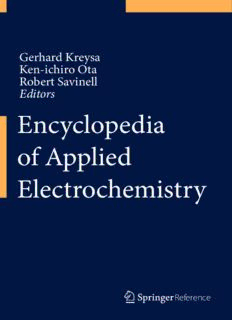
Encyclopedia of Applied Electrochemistry PDF
Preview Encyclopedia of Applied Electrochemistry
Gerhard Kreysa Ken-ichiro Ota Robert Savinell Editors Encyclopedia of Applied Electrochemistry 1 3 Reference Encyclopedia of Applied Electrochemistry Gerhard Kreysa (cid:129) Ken-ichiro Ota Robert F. Savinell Editors Encyclopedia of Applied Electrochemistry With1250Figuresand122Tables Editors GerhardKreysa RobertF.Savinell Eppstein,Germany CaseWesternReserveUniversity Cleveland,OH,USA Ken-ichiroOta YokohamaNationalUniversity,Fac. Engineering Yokohama,Japan ISBN978-1-4419-6995-8 978-1-4419-6996-5(eBook) ISBNBundle978-1-4419-6997-2(printandelectronicbundle) DOI10.1007/978-1-4419-6996-5 SpringerNewYorkHeidelbergDordrechtLondon LibraryofCongressControlNumber:2014934571 #SpringerScience+BusinessMediaNewYork2014 Thisworkissubjecttocopyright.AllrightsarereservedbythePublisher,whetherthewholeor part of the material is concerned, specifically the rights of translation, reprinting, reuse of illustrations,recitation,broadcasting,reproductiononmicrofilmsorinanyotherphysicalway, andtransmissionorinformationstorageandretrieval,electronicadaptation,computersoftware, orbysimilarordissimilarmethodologynowknownorhereafterdeveloped.Exemptedfromthis legalreservationarebriefexcerptsinconnectionwithreviewsorscholarlyanalysisormaterial suppliedspecificallyforthepurposeofbeingenteredandexecutedonacomputersystem,for exclusiveusebythepurchaserofthework.Duplicationofthispublicationorpartsthereofis permitted only under the provisions of the Copyright Law of the Publisher’s location, in its currentversion,andpermissionforusemustalwaysbeobtainedfromSpringer.Permissionsfor usemaybeobtainedthroughRightsLinkattheCopyrightClearanceCenter.Violationsareliable toprosecutionundertherespectiveCopyrightLaw. Theuseofgeneraldescriptivenames,registerednames,trademarks,servicemarks,etc.inthis publicationdoesnotimply,evenintheabsenceofaspecificstatement,thatsuchnamesare exemptfromtherelevantprotectivelawsandregulationsandthereforefreeforgeneraluse.While the advice and information in this book are believed to be true and accurate at the date of publication, neither the authors nor the editors nor the publisher can accept any legal responsibilityforanyerrorsoromissionsthatmaybemade.Thepublishermakesnowarranty, expressorimplied,withrespecttothematerialcontainedherein. Printedonacid-freepaper SpringerispartofSpringerScience+BusinessMedia(www.springer.com) Preface Electrochemistry provides the opportunity to run chemical redox reactions directly with electrons as reaction partners and against the free energy gradientviaexternalelectricalenergyinputintothereactionsystem.Italso servesasawaytoefficientlygenerateenergyfromstoredenergyinchemical bonds. Applied electrochemistry has been the basis for many industrial processesrangingfrommetalsrecoveryandpurificationtochemicalsynthe- sis and separations since the latter half of the 1800s when large-scale elec- tricity generation became possible. Electrochemical processes have a large impactonenergyasithasbeenestimatedthattheseprocessesconsumeabout 6–10%oftheworld’selectricitygenerationcapacity.Appliedelectrochem- istryisnowimpactingindustryandsocietymoreandmorewithtechnologies for waste water treatment, efficient chemical separation, andenvironmental sensingandremediation.Electrochemistryisthefoundationforelectrochem- ical energy storage by batteries and electrochemical capacitors and energy conversionbyfuelcellsandsolarcells.Infact,appliedelectrochemistrywill playamajorroleintheworld’sabilitytoharnessanduserenewableenergy sources.Electrochemistryisalsofundamentaltobiologicalcelltransportand manyaspectsoflivingsystemsandtheiractivities.Itisexploitedforusein medicaldiagnosticstodetectabnormalitiesandinbiomedicalengineeringto relievepainanddeliverfunction. Theapplicationofelectrochemistryinvolvesnotjustafundamentalunder- standing of the sciences, but also applying engineering principles to device and technology design by considering mass and energy balances, transport processes in the electrolyte and at electrode interfaces, and multi-scale modeling and simulation for predicting and optimizing performance. The interaction of the interfacial reactions, the transport driving forces, and the electric field defines the field of electrochemical engineering. The under- standingofthescientificandengineeringprinciplesofelectrochemicalsys- tems has driven advances in the application of electrochemistry especially duringthelasthalfcentury. ThepurposeofthiscollectionistosummarizetheA–Zoftheapplication of electrochemistry and electrochemical engineering for use by electrochemists and electrochemical engineers as well as nonspecialists suchasengineersandscientistsofalldisciplines,economists,students,and even politicians. Electrochemical fundamentals, electrochemical processes and technologies, and electrochemical techniques are described by many v vi Preface expertsintheirfieldsfromaroundtheworld,manyfromindustry.Eachentry ismeanttobeanintroductionandalsogivesreferencesforfurtherstudy.With thiscollection,wehopethatcurrenttechnologyandoperatingpracticescan be made available for future generations to learn from. We hope that this encyclopediawillstimulateunderstandingofthecurrentstateoftheartand leadtoadvancesinnewandmoreefficienttechnologieswithbreakthroughs fromnewtheoryandmaterials.Wehopeyoufinditofvaluetoyourwork. GerhardKreysa Ken-ichiroOta RobertF.Savinell Editors-in-Chief Acknowledgments TheEditors-in-Chiefwouldliketoacknowledgethebackingoftheirinstitu- tions in supporting this work. Specifically we want to thank the Technical University of Dortmund (GK), Yokohama National University (KO), and Case Western ReserveUniversity (RFS). We also wanttothankthe topical editors and authors; it is because of their dedication to their fields and hard work that this collection was possible. We thank our families for their understanding of the importance of this project to us and our profession. Finally, we want to thank the editorial staff of Springer, especially Barbara WolfwhoworkedlongandhardonthisprojectandKennethHowellspecif- icallyforencouragingustoembarkonthisprojectandnudgingusalong. vii About the Editors Prof.Dr.rer.nat.Dr.-Ing.E.h.Dr.tekn.h.c.GerhardKreysaRetiredChief ExecutiveofDECHEMAe.V. Gerhard Kreysa was born in 1945 in Dresden. He studied chemistry at the University of Dresden and received his Ph.D. in 1970. In 1973, he joined the Karl Winnacker Institute of DECHEMA in Frankfurt am Main. He developed new concepts for the utilization of three-dimensional electrodes, which became prominent for electrochemical waste water treat- ment in the process industry. He also played a leading role in the clarification ofthe "cold fusion" affaire in1989. In1985,hewas appointed as professor in the Chemical Engineering Department at the University of Dortmund.In1993,hewasappointedashonoraryprofessorattheUniversity of Regensburg. From 1985 to 1995, he served as executive editorial board memberoftheJournalofAppliedElectrochemistry.Hewasarecipientofthe Chemviron Award in 1980, the Max-Buchner-Research-Award of DECHEMA and the Castner Medal of the Society of Chemical Industry in 1994,andtheWilhelmOstwaldMedaloftheSaxonAcademyofSciencesin Leipzigin2006. From1992to2009,Dr.KreysaservedaschiefexecutiveofDECHEMA SocietyofChemicalEngineeringandBiotechnologyinFrankfurtamMain, Germany. During this time he also served as general secretary of the Euro- pean Federation of Chemical Engineering and the European Federation of Biotechnology. He obtained many distinctions: Honorary doctor degrees of TechnicalUniversityofClausthalandoftheRoyalInstituteofTechnologyin Stockholm,ForeignMemberoftheRoyalSwedishAcademyofEngineering Sciences, elected honorary fellow of the Institution of Chemical Engineers, andhonorarymemberoftheCzechSocietyofChemicalEngineering.In2007 ix
Description: